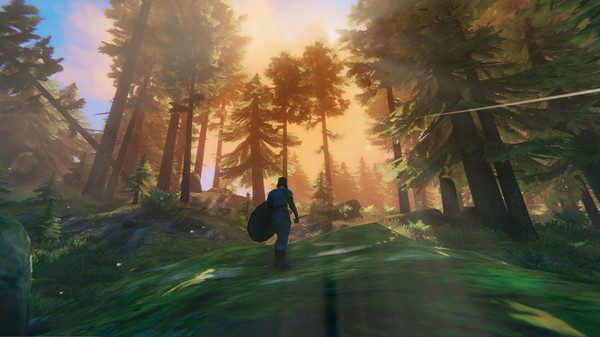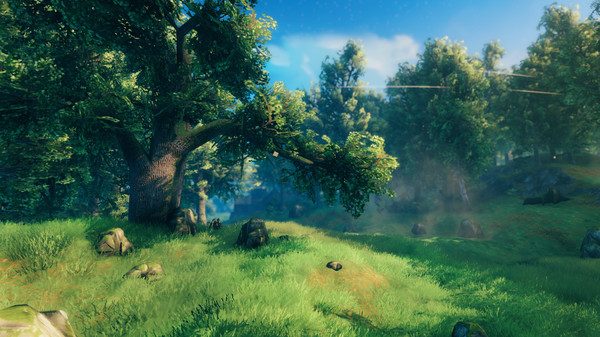But though you don’t have to factor eating into your basic needs for survival, consuming the best food regularly is still extremely beneficial. Cooked recipes in particular can restore your health and give your stamina a much-needed temporary boost. On this page:
How hunger and eating works in Valheim All recipes in Valheim Edible raw foods Cooking station recipes Cauldron recipes Best recipes in Valheim
How hunger and eating works in Valheim
Valheim has a pretty interesting take on hunger and eating mechanics. Your character’s stomach works like an inventory with three slots. You can’t exceed the inventory limits (i.e. overeat). After consuming three pieces of food, you have to wait to eat again until one slot frees up. Fortunately, this takes care of itself — you don’t have to escort your character to the Little Vikings’/Valkyries’ Room. Your hardened warriors are also surprisingly fussy about maintaining a balanced diet. You can’t fill two stomach slots with the same food at the same time. So, though it goes against RPG tradition, you can’t devour your way through a stack of (say) raspberries for a quick multi-part boost to your stats.
Instead, you can eat one raspberry and save the rest for later, when the effects of the first one have worn off. You could, however, happily chow down on anything from a raw carrot to a piece of cooked meat to a heaping serving of stew quite comfortably while digesting that raspberry, assuming you had more slots available. Eating any edible item gives you two boosts:
Health: All food items restore a certain number of health points when you eat them. If you’re below your base health, it’s instantly restored to minimum (25 points). After that, you’ll gain a given number of health points every tick (that’s ten seconds) until the food’s maximum is reached or your health bar is full. Stamina: All food items give you a temporary stamina boost, the strength of which varies depending on what you ate. Stamina boosts have a duration of between five and 40 minutes.
All recipes in Valheim
There are currently twenty-one items on the menu in Valheim, falling into three main categories:
Edible raw foods Cooking station recipes Cauldron recipes
Edible raw foods
Many foods in Valheim are simply inedible raw. This includes all types of meat, as well as flour and some plants.
However, there are quite a few foods you can chow down on as quickly as you can pick them up. They don’t convey as many benefits as cooked foods, but they can be very useful snacks for health and stamina boosts in a pinch.
Cooking station recipes
The cooking station is available to craft from the beginning of the game. It needs to be placed over a campfire. It doesn’t let you cook anything particularly fancy, but it can convert raw meats into something that’s OK to eat. The yield from the cooking station works on a simple one-to-one ratio. Each piece of raw food you cook will be converted into one piece of cooked food or coal.
Cooking times vary and are included on the table. Exceeding them causes food to burn and become inedible. This isn’t a complete waste, as it does give you coal. Coal is an important resource, although there are better ways to get it than to waste your precious food supply, especially early on. Some more advanced recipes require you to pre-cook ingredients. Therefore you’ll still need a cooking station, even once you’ve moved on to the cauldron.
Cauldron recipes
The cauldron is the most state-of-the-art piece of culinary equipment in Valheim. It’s not limited to soups and stews: you prepare meats and even make pies and bread in a cauldron. Cauldron recipes are more complex than what you prepare at the cooking station, requiring multiple ingredients. However, they yield four servings each, and are more beneficial to consume.
You unlock the ability to craft and use a cauldron after you smelt tin for the first time. You can also use the cauldron to brew bases for meads — powerful potions that can be crafted in the Fermenter.
Best recipes in Valheim
Until fairly late in the game, serpent stew is the unrivalled breakfast, lunch, and dinner of champions. Almost every other really high-scoring food requires you to have a windmill to mill barley into flour. You won’t have access to the necessary crafting components until after you defeat Moder, the game’s fourth boss. Serpent stew isn’t without its complexities as a recipe — it requires you to construct and tend to beehives in your base, as well as bravely head out into the ocean to hunt sea serpents for their meat. But since none of this is locked off behind story progression, serpent stew is attainable relatively early on in the game.
Once you do have that windmill, flour-based foods become the best recipes in the game:
Blood pudding gives the best possible boost to health, though only a medium boost to stamina. Fish wraps give the best possible boost to stamina, though only a medium boost to health. Lox meat pie, along with your old friend serpent stew, strikes a happy medium. Both give equal boosts to health and stamina, and the second-highest in the game for both. All four have the longest benefit duration of any food in the game (40 minutes).
Eating three of the four in combination — chosen depending on your needs and the resources you have available — will give the highest possible health and stamina boost. Note that while the stat boosts stack, duration doesn’t. So if you eat three of these foods in one go, their considerable combined benefits will still last 40 minutes total.




